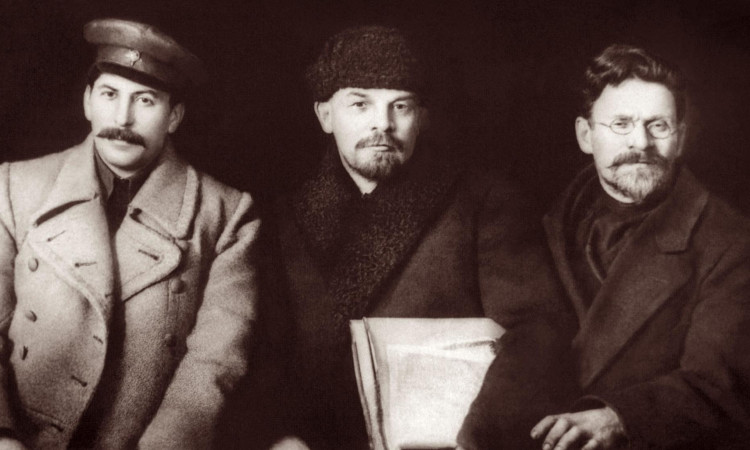In 2009, Comrade Ella Rule made a presentation to the Stalin Society in London, the text of which was subsequently published by the Stalin Society under the title The Katyn Massacre. This short pamphlet set out the Soviet case, proving that it was not the USSR but the Germans who had perpetrated the atrocity, in which over 10,000 Polish prisoners of war were killed and their bodies packed sardine-style into a massive grave in the forest near Katyn in the Smolensk district of Ukraine.
The pamphlet explained that the Polish prisoners of war – officers in the Polish army – had been taken in September 1939, when the Soviet Union occupied a part of what was then Poland, although it had, in view of its majority Ukrainian and Byelorussian populations, originally been proposed to be allocated to the Soviet state following the first world war when the ‘great powers’ drew up the line of demarcation between the Soviet and Polish borders (ie, the Curzon line). During the wars of intervention against the Soviet state, the Poles seized back the area in question, only to have the Soviet Union seize it back in turn in 1939, as it made its preparations to defend itself from Nazi aggression.
It was at this time that the Polish army, which had sought to prevent the recapture, found its personnel captured in large numbers by the Soviet army and confined to camps for prisoners of war.
The Stalin Society pamphlet did not go into intricate detail as to what happened afterwards to these prisoners, but of course a very large number did end up in a mass grave in the forest near Katyn, and the pamphlet focused on the evidence that showed it was the Nazis who had murdered them after they overran the area after 22 June 1941.
It mentioned the fact that the bullets found in the grave were of German manufacture; it quoted some of the testimony given by local people to the Soviet enquiry into what had happened; and it mentioned the documents found on the bodies that bore dates later than when the Nazis had claimed the ‘Soviet massacre’ had taken place – namely, March-April 1940, when the area was still under Soviet control.
Whereas the Stalin Society pamphlet limited itself to setting out ‘our side of the story’ in face of the overwhelming bourgeois political, academic and media support for the Nazi version, Professor Grover Furr’s book goes deeply into the details of the whole affair to find incontrovertible evidence of who the culprits really were.
Whereas the Stalin Society was unashamedly partisan in seeking to acquit the Soviet Union of this dastardly crime (which, contrary to what Professor Furr believes, would not have prevented it from accepting it was wrong if the evidence had so demanded), the Mystery of the Katyn Massacre seeks to be completely impartial, weighing up every bit of evidence adduced by both sides, with one interest in mind, and one only – ie, finding the truth; the real answer to the ‘mystery’.
In April 1943, two months after their defeat at Stalingrad made their loss of the war pretty much inevitable, the Nazis came up with the ‘discovery’ of the mass grave at Katyn containing the bodies of hundreds of Polish officers, most of them in full uniform, whose murder the Nazis attributed to the Soviets while they were occupying the territory between September 1939 and June 1941.
The Germans published a ‘report’ to that effect; and, after the Soviets regained the territory, the USSR set up a commission of enquiry that published a report blaming the Germans.
Which of the reports is the one to be trusted?
When Gorbachev came to power in the USSR, he ‘confessed’ that it was the Soviets who were responsible, and produced by way of proof some documents allegedly filed as top secret in the Soviet archives, which had been opened up following the overthrow of socialism in the Soviet Union.
The Stalin Society dismissed this ‘evidence’ on the basis of Gorbachev’s undoubted interest in maligning the Soviet era and required nothing more. Professor Furr, however, has gone further and has been able conclusively to establish that at least one of the documents was nothing but a crude forgery, which of course impugns the validity of the others.
Those intent on establishing that the ‘Soviets did it’ would attack all the evidence adduced to establish German guilt on the basis that either: 1. there was an alternative explanation (eg, for why the bullets were German); 2. that eye witnesses were pressurised into lying; and 3. that documents were forged.
And, of course, if the perpetrators had been the Soviets, then they would be saying the same about evidence adduced by the Nazis and their supporters. So Professor Furr set out to isolate the evidence that could not have been falsified in any way.
If the evidence is admitted by both sides, it can be assumed that it has not been falsified. Thus it is admitted that Polish prisoners who had been held at PoW camps in Ostashkov, Starobelsk and Kozelsk were removed en masse from these camps in April and May 1940, and that those from Ostashkov were taken to Kalinin; those from Starobelsk were taken to Pyatkhatky, and those from Kozelsk were taken to Smolensk.
Soviet transit lists of the names of all the prisoners involved in each convoy confirm this was the case. What is totally lacking is any evidence whatever that these convoys were ‘death transits’, as is emotionally asserted by various bourgeois writers without a shred of proof. It is also acknowledged by everybody that the bullet cases found in the graves were of German manufacture.
Inconvenient evidence
Evidence can also be assumed to be valid if it is admitted by one of the sides but actually goes against them, mainly because at the time in question they did not realise the implications arising from it.
Thus the Germans listed many items among the possessions of the victims without realising that some of them necessarily dated from after the murders were alleged to have occurred. Although there was only very little in the graves with later dates on them, that little is very telling: a prayer book nobody obviously thought to check marked inside with a date in 1941, for instance.
An amusing oversight was a photograph listed by the Germans as being in the possession of one of the corpses. It was described as bearing the inscription “Hanina Gajowska, Lemberg …” What was obviously overlooked is that ‘Lemberg’, the German name for Lvov, did not exist until June 1941 – over a year after the Soviets had allegedly murdered the Polish officers, when the city was captured by the Germans! (See p118)
A similar error was made in the case of the town of Lodz, which lies to the west of the Curzon line, and which the Germans renamed Litzmannstadt when it was captured by them in April 1940, round about the same time that they were to claim the Soviets were killing the Polish officers.
There were no fewer than three separate identity documents listed by the Germans as having been found on the corpses that referred to Litzmannstadt, even though it would have been impossible for such identity papers to be issued to them in the four days it took, in the case of one of them, to be transferred out of his PoW camp to meet his supposed death at Soviet hands. They must have been issued later, and may even have been forgeries, since one at least contains a misspelling of a Polish name.
Another corpse was found to be in possession of a draft letter to the commandant in charge of his PoW camp – written in German! Why would a Polish man write to a Soviet commandant in German? So much more likely that the letter was written after the Germans had taken control of the PoW camps.
Another marker can be undeniable attempts at subterfuge and, of course, proven forgeries. An example of obvious subterfuge arises in the case of the German bullets. The Germans explained these away by saying that they had some years previously been supplying the Soviet Union with armaments, including bullets.
The bullets in fact came from the Gustav Genschow firm, as was clear from the markings on the shell casings found in the grave. The Nazis carefully photographed the shell casings from the side, rather than photographing their bases, on which the factory markings appeared. Instead, they asked the firm to confirm that shell casings with certain markings verbally described had been supplied to the Soviet Union, which the firm agreed they had been.
However, it supplied copies of shell casing marking on bullets supplied to the Soviets: bullet casings from 1922 sported a single D and no other marking; those from 1931 were marked ‘Geco 7.65DD’ and in 1932 they used Geco 7.65. However, one of the verbal descriptions given in evidence was ‘Geco 7.65D’, a stamp which the firm never used.
As Professor Furr notes, in a footnote on page 40, it is difficult to believe that this mistake could have been made if there were indeed thousands of casings lying around the graves from which the wording could be copied exactly. It is, however, extremely significant that the German factory was not sent photographs of the case markings to be used to identify the manufacturing batch, but only photographs of the sides of the cases, which would have been of little use for identification purposes. Had the ‘investigators’ provided such evidence, they clearly would not have got the answers they wanted!
Of course, for the proponents of the theory that ‘the Soviets did it’, the most incontrovertible proof is the confession issued by Gorbachev, supposedly after the ‘truth’ was revealed consequent upon the opening of the secret archives. Professor Furr proves beyond any shadow of reasonable doubt that at least one of these ‘secret archival documents’ can only be a forgery.
It is an apparent carbon copy dated 1959 (!) of another document (pages excerpted from Protocol no 13 of the Politburo session of 5 March 1940), which nevertheless adds Stalin’s name as signatory (six years after his death!) and is stamped with a Communist Party seal of a type not issued until 1952. It is a complete mystery why such a document should have been included in the alleged ‘evidence’ of Soviet responsibility for the Katyn massacre, but it is certainly excellent evidence that forgers were at work practising their somewhat limited skills.
Inconvenient corpses
What originally put Professor Furr on the track to disproving the Nazi attempts to blame the Soviets for Katyn was the discovery in 2011 of another mass grave containing 57 corpses at Volodymyr-Volynskiy in northwest Ukraine, which was again attributed by all bourgeois sources to the Soviet Union and Stalin.
Here, however, the Nazis were not in control of the crime scene, and as a result it quickly came to light that the shell casings found were overwhelmingly of German manufacture, and also that they dated from 1941, when Germany would certainly not have been supplying them to the Soviet Union.
Even more telling is that with the corpses were found the badges of two Polish policemen who had been listed as having been killed in 1940 by the Soviets, on the basis that they had been transported from their PoW camp at Ostakhov to Kalinin, where they were almost immediately murdered and then buried in nearby Mednoye (though this grave has never been found).
The fact that their bodies in fact appeared at Volodymyr-Volynskiy, where it can only have been the Germans who killed them, was a real smoking gun that pointed unwaveringly at the Nazi fabrications regarding the Katyn massacre.
According to the Nazis, only PoWs from Kozelsk were taken to Katyn and ended up buried there. When Professor Furr investigated the lists, prepared by the Germans, of the possessions found on the corpses, he discovered that these included badges that would only have been issued to prisoners from other camps.
This proved that the Soviet transit lists that the Nazis had acquired after they invaded Ukraine were not death lists at all, but, as the Soviets had claimed, lists of people to be transported to western Ukraine to work on projects such as road building.
Housed in camps labelled 1, 2 and 3, they all fell into German hands after the German invasion of Ukraine in June 1941. It is only this that can explain the presence in the Katyn mass grave of prisoners originating from camps other than Kozelsk.
Professor Furr concludes, after examining all the evidence he establishes to be incontrovertible, that all of it points to the Nazis having perpetrated the atrocity, not the Soviets.
It has only been possible in this short article to highlight a few points from the mass of evidence that Professor Furr has examined with meticulous attention to detail, so we would thoroughly recommend readers seeking the whole truth and nothing but the truth to read the book itself.
In particular, the ordinary working people of Poland, many of whom have been duped into taking up a position of both anticommunism and hatred of Russia on the basis of the accusation that the Soviets were responsible for the Katyn massacre, need to have this book brought to their attention so that they can: (a) learn the truth, and (b) realise how the bourgeois thieves who organised the restoration of capitalism and reduced them to poverty and, in many cases, economic exile, are trying to dupe them in order to prevent them from regaining the socialist state that they have lost.
*****
Book details:
Grover Furr, The Mystery of the Katyn Massacre: The Evidence, the Solution
Erythros Press and Media, Kettering Ohio, 2018
ISBN 978-0-692-13425-2















